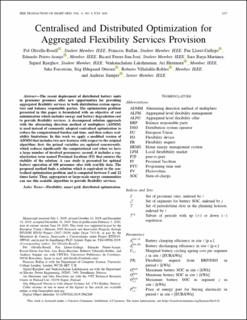| dc.contributor.author | Olivella-Rosell, Pol | |
| dc.contributor.author | Rullan, Francesc | |
| dc.contributor.author | Lloret-Gallego, Pau | |
| dc.contributor.author | Prieto-Araujo, Eduardo | |
| dc.contributor.author | Ferrer-San-José, Ricard | |
| dc.contributor.author | Barja-Martinez, Sara | |
| dc.contributor.author | Bjarghov, Sigurd | |
| dc.contributor.author | Lakshmanan, Venkatachalam | |
| dc.contributor.author | Hentunen, Ari | |
| dc.contributor.author | Forsström, Juha | |
| dc.contributor.author | Ottesen, Stig Ødegaard | |
| dc.contributor.author | Villafafila-Robles, Roberto | |
| dc.contributor.author | Sumper, Andreas | |
| dc.date.accessioned | 2021-03-02T14:24:56Z | |
| dc.date.available | 2021-03-02T14:24:56Z | |
| dc.date.created | 2021-02-10T17:15:59Z | |
| dc.date.issued | 2020 | |
| dc.identifier.citation | IEEE Transactions on Smart Grid. 2020, 11 (4), 3257-3269. | en_US |
| dc.identifier.issn | 1949-3053 | |
| dc.identifier.uri | https://hdl.handle.net/11250/2731216 | |
| dc.description.abstract | The recent deployment of distributed battery units in prosumer premises offer new opportunities for providing aggregated flexibility services to both distribution system operators and balance responsible parties. The optimization problem presented in this paper is formulated with an objective of cost minimization which includes energy and battery degradation cost to provide flexibility services. A decomposed solution approach with the alternating direction method of multipliers (ADMM) is used instead of commonly adopted centralised optimization to reduce the computational burden and time, and then reduce scalability limitations. In this work we apply a modified version of ADMM that includes two new features with respect to the original algorithm: first, the primal variables are updated concurrently, which reduces significantly the computational cost when we have a large number of involved prosumers; second, it includes a regularization term named Proximal Jacobian (PJ) that ensures the stability of the solution. A case study is presented for optimal battery operation of 100 prosumer sites with real-life data. The proposed method finds a solution which is equivalent to the centralised optimization problem and is computed between 5 and 12 times faster. Thus, aggregators or large-scale energy communities can use this scalable algorithm to provide flexibility services. | en_US |
| dc.language.iso | eng | en_US |
| dc.publisher | IEEE | en_US |
| dc.rights | Navngivelse 4.0 Internasjonal | * |
| dc.rights.uri | http://creativecommons.org/licenses/by/4.0/deed.no | * |
| dc.title | Centralised and Distributed Optimization for Aggregated Flexibility Services Provision | en_US |
| dc.type | Peer reviewed | en_US |
| dc.type | Journal article | en_US |
| dc.description.version | publishedVersion | en_US |
| dc.source.pagenumber | 3257-3269 | en_US |
| dc.source.volume | 11 | en_US |
| dc.source.journal | IEEE Transactions on Smart Grid | en_US |
| dc.source.issue | 4 | en_US |
| dc.identifier.doi | 10.1109/TSG.2019.2962269 | |
| dc.identifier.cristin | 1888656 | |
| dc.description.localcode | This work is licensed under a Creative Commons Attribution 4.0 License. For more information, see https://creativecommons.org/licenses/by/4.0/ | en_US |
| cristin.ispublished | true | |
| cristin.fulltext | original | |
| cristin.qualitycode | 2 | |

